SEGNALAZIONI A BANCA D’ITALIA DEI PUNTI DI ACCESSO AL CONTANTE (PAC) CON LA PIATTAFORMA KNOX
SEGNALAZIONI A BANCA D’ITALIA DEI PUNTI DI ACCESSO AL CONTANTE (PAC) CON LA PIATTAFORMA KNOX Knox produce i dati da inviare a Banca d’Italia tramite Infostat per le nuove segnalazioni PAC che tutte le banche dovranno..
IN ITALIA L’87% DEGLI SPORTELLI BANCARI È GESTITO ATTRAVERSO KNOX!
Nel 2022 e 2023 abbiamo attivato molti nuovi clienti, alcuni dei quali hanno deciso di utilizzare a Knox perché permette di gestire il protocollo POC (Prenotazione Operazioni in Contante) di Banca d’Italia, che è diventato obbligatorio...
KNOX: I NUMERI DEL CASH MANAGEMENT NEL 2022
KNOX: I NUMERI DEL CASH MANAGEMENT NEL 2022 Tramite la piattaforma Knox nel 2022 sono stati effettuati ben 9,5 milioni di ordini (+12% sul 2021), per un ammontare totale del transato pari a 314 miliardi di..
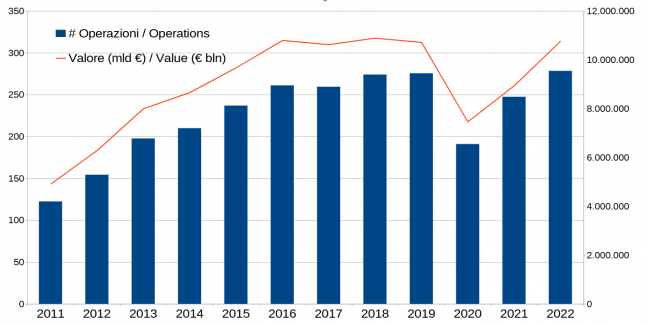
SETTIMANA DI TEAM BUILDING A MALLORCA
SETTIMANA DI TEAM BUILDING A MALLORCA ADAM ha da poco concluso un entusiasmante team building di una settimana a Palma de Mallorca. Durante questa bellissima esperienza abbiamo avuto l’opportunità di rafforzare il nostro legame e migliorare..

IL CONTANTE IN ITALIA NEL 2021
IL CONTANTE IN ITALIA NEL 2021 Abstract La propensione all’uso del contante in Italia ha registrato un calo durante la pandemia, ma nel 2021 ha progressivamente recuperato fino a tornare molto vicina ai livelli preesistenti. La..
ENTRO IL 2022 IL 72% DELLE OPERAZIONI POC (PRENOTAZIONE OPERAZIONI IN CONTANTE) IN BANCA D’ITALIA SARANNO GENERATE DA KNOX
ENTRO IL 2022 IL 72% DELLE OPERAZIONI POC (PRENOTAZIONE OPERAZIONI IN CONTANTE) IN BANCA D’ITALIA SARANNO GENERATE DA KNOX Il sistema POC (Prenotazione Operazioni in Contante) permette di effettuare richieste di contante a Banca d’Italia in..
IL CONTANTE NELL’ANNO DELLA PANDEMIA
IL CONTANTE NELL’ANNO DELLA PANDEMIA Concludiamo la nostra analisi sull’anno della pandemia includendo i mesi che hanno visto l’inizio, per l’Italia, della cosiddetta “seconda ondata” di Sars-CoV2. Per contestualizzare i dati occorre rapportarli alle misure di..
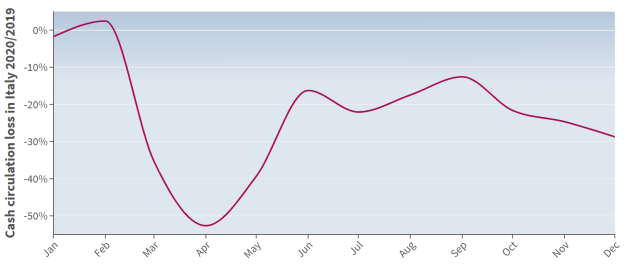
RIPRESA DELLA CIRCOLAZIONE DI CONTANTE IN ITALIA DOPO IL LOCKDOWN
RIPRESA DELLA CIRCOLAZIONE DI CONTANTE IN ITALIA DOPO IL LOCKDOWN Dopo aver analizzato il calo del contante nei mesi più critici della pandemia di COVID-19 in Italia, ci concentriamo ora sul periodo successivo, cercando di capire..
RIDUZIONE DELLA CIRCOLAZIONE DI CONTANTE IN ITALIA DURANTE LA PANDEMIA COVID-19
RIDUZIONE DELLA CIRCOLAZIONE DI CONTANTE IN ITALIA DURANTE LA PANDEMIA COVID-19 La pandemia di Covid-19 e le conseguenti misure restrittive hanno avuto un effetto devastante sull’economia italiana nei primi mesi del 2020. Qual è stato l’impatto..
CONTINUA LA CRESCITA DEI DISPOSITIVI CASH-IN CON PRE-CREDIT
CONTINUA LA CRESCITA DEI DISPOSITIVI CASH-IN CON PRE-CREDIT Continua il grande successo del modulo “GDO Cash System” (GCS) della piattaforma Knox. Il modulo permette la gestione del processo inerente i macchinari Cash-In utilizzati dagli esercenti, inclusa..
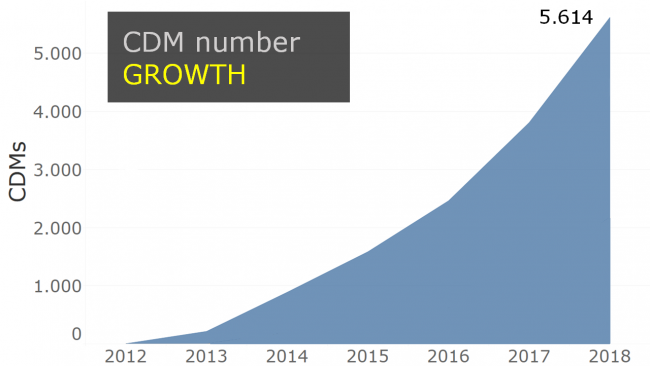
PIÙ POTERE PER I RETAILER
PIÙ POTERE PER I RETAILER Il retailer ha spesso più banche di appoggio, e vuole avere una visione d’insieme dei propri dati senza doversi collegare a una diversa applicazione per ogni banca. Ora questo è possibile..
FINALMENTE ANCHE IN ITALIA LE COMPENSAZIONI MULTI-BANCA
FINALMENTE ANCHE IN ITALIA LE COMPENSAZIONI MULTI-BANCA A maggio 2019 è stato attivato per la prima volta il modulo della piattaforma Knox “Compensazioni senza viaggi in Banca d’Italia”, che consente di compensare le eccedenze e le..

LA CRESCITA DEI DISPOSITIVI CASH-IN CON PRE-CREDIT
LA CRESCITA DEI DISPOSITIVI CASH-IN CON PRE-CREDIT Uno dei moduli della piattaforma Knox che ha avuto più successo negli ultimi anni è sicuramente il modulo “GDO Cash System” (GCS). Il modulo permette la gestione del processo..

KNOX: I NUMERI DEL CASH MANAGEMENT NEL 2018
KNOX: I NUMERI DEL CASH MANAGEMENT NEL 2018 Tramite la piattaforma Knox nel 2018 sono stati effettuati, per le sole agenzie bancarie, ben 9,39 milioni di ordinativi (+5,61% sul 2017), per un ammontare totale del transato..
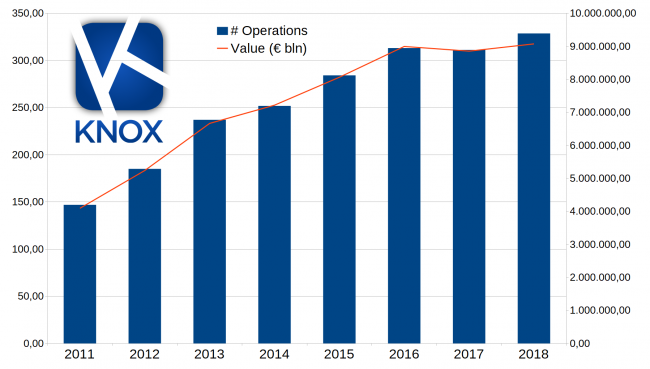
CONVEGNO “THE FUTURE OF CASH” AD ATENE
CONVEGNO “THE FUTURE OF CASH” AD ATENE Ha suscitato grande interesse l’intervento di ADAM al convegno internazionale “The future of cash” ad Atene il 21/02/2019. Mauro Bonaglia, responsabile commerciale di ADAM, ha parlato dei vantaggi dell’approccio..

KNOX: I NUMERI DEL CASH MANAGEMENT NEL 2016
KNOX: I NUMERI DEL CASH MANAGEMENT NEL 2016 Tramite la piattaforma Knox nel 2016 sono stati effettuati, per le sole agenzie bancarie, ben 8,95 milioni di ordinativi (+10.5% sul 2015), per un ammontare totale del transato..
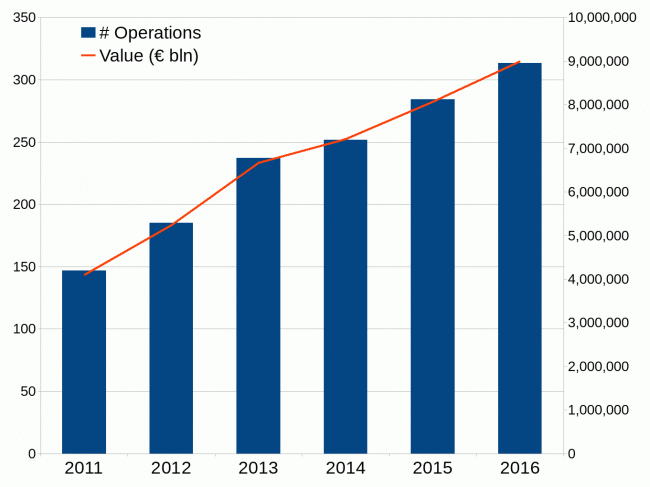
PRENOTAZIONI OPERAZIONI IN CONTANTE (POC) DA E VERSO BANCA D’ITALIA CON LA PIATTAFORMA KNOX
PRENOTAZIONI OPERAZIONI IN CONTANTE (POC) DA E VERSO BANCA D’ITALIA CON LA PIATTAFORMA KNOX Da settembre 2016 Knox è completamente integrato con Banca d’Italia per la gestione delle Prenotazioni Operazioni in Contante (POC) . ADAM ha..
KNOX: I NUMERI DEL CASH MANAGEMENT NEL 2015
KNOX: I NUMERI DEL CASH MANAGEMENT NEL 2015 Tramite la piattaforma Knox nel 2015 sono stati effettuati, per le sole agenzie bancarie, ben 8,1 milioni di ordinativi (+13% sul 2014), per un ammontare totale del transato..
KNOX: UTENTI UNICI
KNOX: UTENTI UNICI Nel giorno medio, nei primi 10 mesi del 2014, hanno usato la piattaforma Knox più di 10.000 utenti.
..KNOX: I NUMERI DEL CASH MANAGEMENT NEL 2013
KNOX: I NUMERI DEL CASH MANAGEMENT NEL 2013 Tramite la piattaforma Knox nel 2013 sono stati effettuati, per le sole agenzie bancarie, ben 6,7 milioni di ordinativi (+22% sul 2012), per un ammontare totale del transato..
KNOX: I NUMERI DEL CASH MANAGEMENT NEL 2012
KNOX: I NUMERI DEL CASH MANAGEMENT NEL 2012 31 marzo 2013: Knox: i numeri del Cash Management nel 2012Tramite la piattaforma Knox nel 2012 sono stati effettuati, per le sole agenzie bancarie, ben 5,5 milioni di..
I NUMERI DEL CASH MANAGEMENT NEL 2011
PRENOTAZIONI OPERAZIONI IN CONTANTE (POC) DA E VERSO BANCA D’ITALIA CON LA PIATTAFORMA KNOX 15 marzo 2012: ADAM – i numeri del Cash Management nel 2011Nel 2011 tramite le soluzioni ADAM sono stati effettuati, per le..
